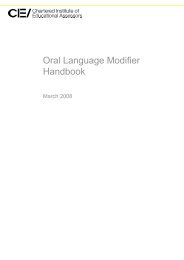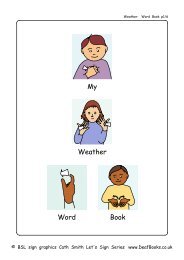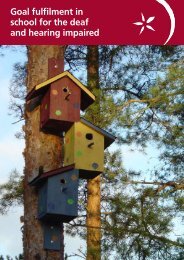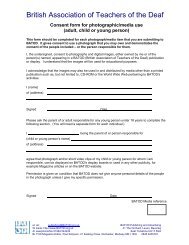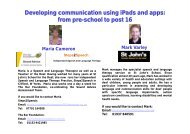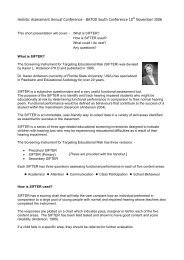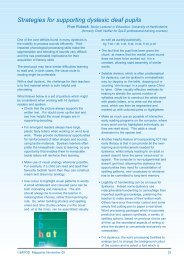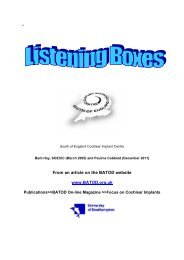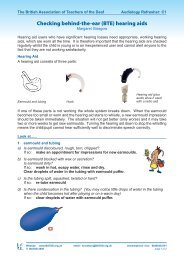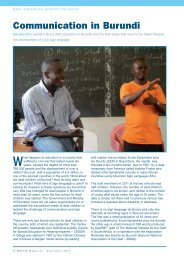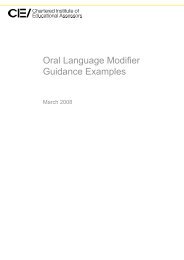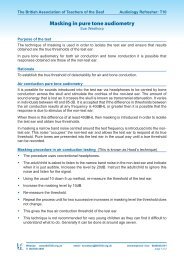Glue Ear and Otitis Media - batod
Glue Ear and Otitis Media - batod
Glue Ear and Otitis Media - batod
You also want an ePaper? Increase the reach of your titles
YUMPU automatically turns print PDFs into web optimized ePapers that Google loves.
The British Association of Teachers of the Deaf<br />
Audiology Refresher: G4<br />
<strong>Glue</strong> ear <strong>and</strong> otitis media<br />
Margaret Glasgow ©BATOD Magazine January 01 page 33-34<br />
Fluid in the middle ear (otitis media with effusion) is the most common cause of temporary or fluctuating<br />
conductive hearing loss. One in ten children will have acute otitis media at some time. Most children will have<br />
an episode of secretory otitis media. Children with sensori-neural hearing loss can also be affected. It is most<br />
common in young children up to six years of age because of the position, size <strong>and</strong> poorer function of the<br />
eustachian tubes.<br />
Acute otitis media (ear infection)<br />
This is a viral or bacterial infection in the middle ear. It can occur with colds, sore throats, influenza <strong>and</strong> other<br />
respiratory illnesses. Severe ear ache <strong>and</strong> a conductive hearing loss can occur.<br />
Secretory otitis media (<strong>Glue</strong> <strong>Ear</strong>)<br />
<strong>Glue</strong> <strong>Ear</strong> occurs when fluid collects in the middle ear space of one or both ears. Bacteria gets into the middle<br />
ear <strong>and</strong> causes an inflammation of the lining, often after a cold, throat or ear infection. The adenoids often<br />
swell, or tonsils become enlarged, blocking the eustachian tube <strong>and</strong> making the situation worse. The air which<br />
is trapped in the middle ear is absorbed by the surrounding cell lining <strong>and</strong> bony structure <strong>and</strong> a negative<br />
pressure is formed. To balance this negative pressure fluid from the cells drains in to fill up the space. The<br />
fluid is often quite thin <strong>and</strong> runny but in time may become thicker, like glue. If the fluid is infected, the tympanic<br />
membrane may burst <strong>and</strong> blood-stained pus run from the ear.<br />
Obvious signs of <strong>Glue</strong> <strong>Ear</strong><br />
mouth breathing <strong>and</strong>/or snoring at night (due to enlarged adenoids)<br />
speaking loudly or shouting,saying “eh”, “pardon” or “what” more often<br />
turning volume up on television/failure to hear sounds that can’t be seen eg traffic<br />
fluctuating hearing or attention.<br />
Diagnosis<br />
Otoscopy gives a view of the condition of the tympanic membrane <strong>and</strong> tympanometry gives information about<br />
the movement of the tympanic membrane, whether there is glue in the middle ear <strong>and</strong> the state of the<br />
eustachian tube. Behavioural tests, pure tone audiograms, including bone conduction <strong>and</strong> speech<br />
discrimination tests all give extra information. The conductive hearing loss may well fluctuate <strong>and</strong> be mild or<br />
moderate in degree.<br />
Sound waves hitting the tympanic membrane are normally conducted across the air-filled cavity of the middle<br />
ear by the ossicular bones. However, when the middle ear cavity is full of thick viscous fluid it is more difficult<br />
for the bones to move <strong>and</strong> the sound is therefore dampened. Everyone experiences this when they have a<br />
heavy cold <strong>and</strong> their hearing is affected.<br />
Treatment<br />
There is much controversy over the treatment of <strong>Glue</strong> <strong>Ear</strong>. It is often is short term <strong>and</strong> rarely has a permanent<br />
damaging effect on the ear.<br />
The condition may clear up by itself or a variety of treatments may be used:<br />
medication – antibiotics, decongestants, ear or nose drops<br />
homoeopathic remedies/dairy free diet<br />
cranial massage<br />
hearing aids<br />
myringotomy – the ‘glue’ is removed from the middle ear after piercing the ear drum with a syringe whilst<br />
under anaesthetic<br />
grommets or T-tubes – these are inserted into the tympanic membrane whilst the child is under<br />
anaesthetic. Tonsils <strong>and</strong> adenoids are sometimes removed at the same time. The grommet allows air to<br />
circulate within the middle ear <strong>and</strong> prevents further build up of glue whilst it is in place. Grommets are<br />
temporary <strong>and</strong> are eased out into the ear canal as the tympanic membrane heals. T-tubes are fitted in<br />
more persistent cases eg children with Downs Syndrome. These have to be removed under anaesthetic.<br />
Multiple insertion of grommets can badly scar the eardrum.<br />
Website: www.BATOD.org.uk email: secretary@BATOD.org.uk Answerphone / fax: 08456435181<br />
© BATOD 2009 page 1 of 2
The British Association of Teachers of the Deaf<br />
Audiology Refresher: G4<br />
Effects of a conductive hearing loss caused by otitis media<br />
child may become quiet, withdrawn, irritable, tired <strong>and</strong> generally less communicative or alternatively child<br />
may be more active or physical<br />
child may use voice less frequently <strong>and</strong> take less notice of speech<br />
if child is already speaking, the speech may become less clear<br />
new words may not be learned <strong>and</strong> little progress made in the child’s speech <strong>and</strong> language development<br />
child may experience difficulty at school with literacy <strong>and</strong> numeracy skills<br />
child may become unsettled at nursery or school <strong>and</strong> feel left out of activities<br />
child may daydream <strong>and</strong> appear to hear selectively<br />
child may have poor listening skills due to inconsistent listening experiences.<br />
A child who has recurring conductive hearing loss due to glue ear in the early years may experience hearing<br />
losses at times to a threshold of 60 to 70 dBHL. A young child who has consistently had poor hearing will not<br />
have the linguistic experience to predict words when heard inaccurately. This results in poor vocabulary <strong>and</strong><br />
underst<strong>and</strong>ing of concepts when starting at nursery or infant school. A conductive hearing loss affects all<br />
speech frequencies. Poor speech discrimination of the voiceless fricatives in particular means that the markers<br />
for tense, number <strong>and</strong> possession are missed. The Literacy Hour <strong>and</strong> Numeracy Strategy in school concentrate<br />
on the early introduction of phonics <strong>and</strong> mental arithmetic. These learning objectives are particularly difficult<br />
for children with a fluctuating hearing loss, who may be mistaken for being unresponsive, disruptive or of limited<br />
ability.<br />
Children’s hearing difficulties are often not identified until their speech <strong>and</strong> vocabulary do not develop at the<br />
normal rate. This may be noticed at home, nursery or infant school. It can affect cognitive, social <strong>and</strong> linguistic<br />
development, particularly for children who may have an additional learning difficulty.<br />
1. Grommet<br />
2. View of eardrum with<br />
grommet in situ<br />
3. Cross section of ear:<br />
grommet in situ<br />
Website: www.BATOD.org.uk email: secretary@BATOD.org.uk Answerphone / fax: 08456435181<br />
© BATOD 2009 page 2 of 2



